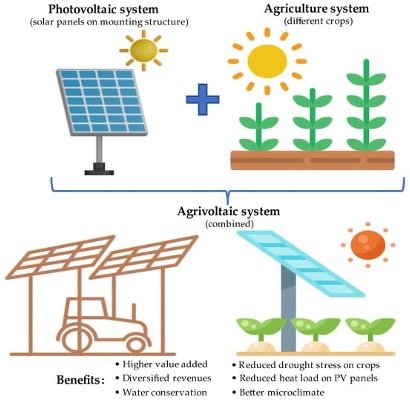Agrivoltaics: a sustainable fusion of agriculture and solar energy


· 4 min read
By integrating power resources into agricultural practices, agrivoltaic (AV) systems represent a novel approach to farming, blending crop cultivation, power generation, and various agricultural activities. This innovative model is a part of the broader movement called “Agriculture 5.0” seeking to harmonize energy and food production.
While experiments on the technology are still ongoing, more than 2200 AV systems have been installed globally since 2014, resulting in a capacity of over 2.8 GW as of January 2020.
The effectiveness of AV systems lies in their ability to increase land use efficiency, a critical challenge in harmonizing the photovoltaic and agricultural industries. Among many studies, Hassanpour Adeh et al. (2018) show that AV systems substantially impact environmental parameters such as average air temperature, relative humidity, wind speed, wind direction and soil moisture. By realizing combinations of such parameters, AV can improve the efficiency in the utilization of various resources. For example, photovoltaic (PV) panels can be placed at heights of 2-5 meters, so that agricultural activities can continue underneath, optimizing land use (Figure 1).
Figure 1. Comparison diagram of Agrivoltaic system and PV systems on the same agricultural land

Source: Chalgynbayeva et al. (2023)
Aside from optimizing land use, having crop and electricity production in the same land can facilitate competition for land. In India, for instance, implementing AV with grape crops not only maintained food yields but also potentially increased the economic value of agricultural production by over 15 times annually.
Research confirms the advantages of Agrivoltaics. In a 2016 study by Dinesh-Pearce, the results of a coupled simulation show that the value of solar energy production coupled with shade-tolerant crop production has led to an economic value increase of more than 30% on farms using AV systems instead of conventional agriculture.
Despite the higher initial investment and operating costs of AV systems compared to conventional PV or crop production, they offer dual revenue streams: electricity and crops. The significant decrease in the capital expenditure (CAPEX) of PV systems, from 3.5 to 0.3 USD/W between 2010 and 2020, supports the feasibility of AV systems. According to the literature (Poonia et al., 2022), Large-scale AV installations are particularly economically viable, while levelized cost of electricity (LCOE) – a crucial indicator of competitiveness – was found to be lower for AV systems in certain contexts.
While German experiences have shown that while AV systems have higher investment costs, their operational expenses are generally lower than typical PV installations (by roughly 13%), mainly due to reduced (dual) land, maintenance, and surveillance costs.
Finally, AV systems can be regarded as win-win options for both farmers and investors (IRR > 8% in baseline scenario), even if the yields of the considered vegetables show a reduction of 20% (Moreda et al., 2021). When considering more favourable geographical conditions and biomass productivity, it's expected that the effectiveness of AV systems could be significantly higher in tropical areas than in advanced economies. This potential for greater competitiveness makes AV systems an appealing option for investors in these tropical regions.
The future of AV lies in optimizing the configuration and layout of solar panels, identifying the most suitable crops for varying conditions, and understanding the impact on market prices of electricity, solar panels, and agricultural products. As research continues, AV systems are poised to become a cornerstone of sustainable agriculture and energy production, heralding a new era of efficiency and environmental stewardship in the agricultural sector.
Future Thought Leaders is a democratic space presenting the thoughts and opinions of rising Sustainability & Energy writers, their opinions do not necessarily represent those of illuminem.
Chalgynbayeva, A., Gabnai, Z., Lengyel, P., Pestisha, A., & Bai, A. (2023). Worldwide Research Trends in Agrivoltaic Systems— A Bibliometric Review. Energies, 16(2).
Dinesh, H., & Pearce, J. M. (2016). The potential of agrivoltaic systems. Renewable and Sustainable Energy Reviews, 54, 299–308.
Hassanpour Adeh, E., Selker, J. S., & Higgins, C. W. (2018). Remarkable agrivoltaic influence on soil moisture, micrometeorology and water-use efficiency. PloS One, 13(11), e0203256.
Moreda, G. P., Muñoz-García, M. A., Alonso-García, M. C., & Hernández-Callejo, L. (2021). Techno-economic viability of agro-photovoltaic irrigated arable lands in the eu-med region: A case-study in southwestern spain. Agronomy, 11(3), 593.
Poonia, S., Jat, N., Santra, P., Singh, A., Jain, D., & Meena, H. (2022). Techno-economic evaluation of different agri-voltaic designs for the hot arid ecosystem
illuminem briefings

Agriculture · Public Governance
Michael Wright

Agriculture · Environmental Sustainability
Yury Erofeev

Food · Agriculture
Politico

Climate Change · Agriculture
The Guardian

Climate Change · Agriculture
The Guardian

Agriculture · Climate Change